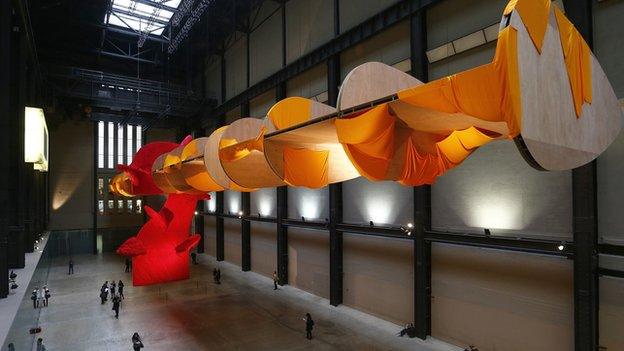Compost and soil fill Tate's Turbine Hall
- Published
Abraham Cruzvillegas describes his work
More than 23 tonnes of soil and compost have filled Tate Modern's Turbine Hall in the latest installation to occupy the famous space in London.
The sculpture by Mexican artist Abraham Cruzvillegas, called Empty Lot, consists of two triangular platforms filled with wooden planters.
Nothing has been planted in them but flowers etc. could grow, depending on what seeds are already in the soil.
The compost and soil has been collected from parks and gardens across London.
BBC Entertainment Live: News updates
The Empty Lot opens to the public on 13 October and will remain until 3 April 2016.

By David Sillito, media correspondent
Twenty-three tonnes of soil, including several hundred kilos from Buckingham Palace, have gone on display at Tate Modern in London. The artwork is called Empty Lot and is the latest exhibition in the Tate's huge Turbine Hall. The soil has come from across London, some brought by bike in bags from people's gardens. Arranged in triangular raised beds - the work by Mexican artist Abraham Cruzvillagas - echoes his own community in Mexico city in which people built their own homes and gardened any spare patch of land. Under horticultural lighting the soil will be watered every day to see what might sprout through the dark days of an English winter. Nothing has been planted but a few green shoots have already appeared - it is then a chance to watch grass grow, and, the artist says, think about the invisible ingredient - hope.

For the duration of the project, the soil will be lit by lampposts constructed by the artist using materials found in skips and building sites around Tate Modern, which is situated near the Thames in London's Bankside area.
The project feeds into Cruzvillegas's interest in guerrilla gardening and ancient "chinampas", small grids of earth used to grow corn, peppers and tomatoes in the area that later became Mexico City.
For the past few years, Cruzvillegas has created a body of work called Autoconstruccion (Self-construction), which refers to the way his parents' generation arrived in the capital from rural areas in the 1960s and built their own houses in stages, improvising whatever materials they could source.
Cruzvillegas was born in Mexico City in 1968, where he still lives and works.
His work has been exhibited in galleries including Tate Modern and the Museum of Modern Art in New York.
- Published20 January 2014
- Published13 October 2014
